
by Dr. Daniel Wagner, Expedition Coordinator
August 31, 2019

Map showing the in port location in Dartmouth, Nova Scotia, where NOAA Ship Okeanos Explorer was docked prior to the start of leg 2 of the Deep Connections 2019 expedition. Image courtesy of the NOAA Office of Ocean Exploration and Research, Deep Connections 2019. Download image (jpg, 1.8 MB).
NOAA Ship Okeanos Explorer, also known as “America’s ship for exploration,” is the only U.S. federal vessel dedicated to exploring our largely unknown ocean for the purpose of discovery and the advancement of knowledge. In close collaboration with government agencies, academic institutions, and other partners, NOAA’s Office of Ocean Exploration and Research (OER) conducts deep-sea exploration expeditions using advanced technologies on NOAA Ship Okeanos Explorer. From mapping and characterizing previously unseen seafloor, to collecting and disseminating information about great ocean depths, this work helps to establish a foundation of information to fill data gaps.
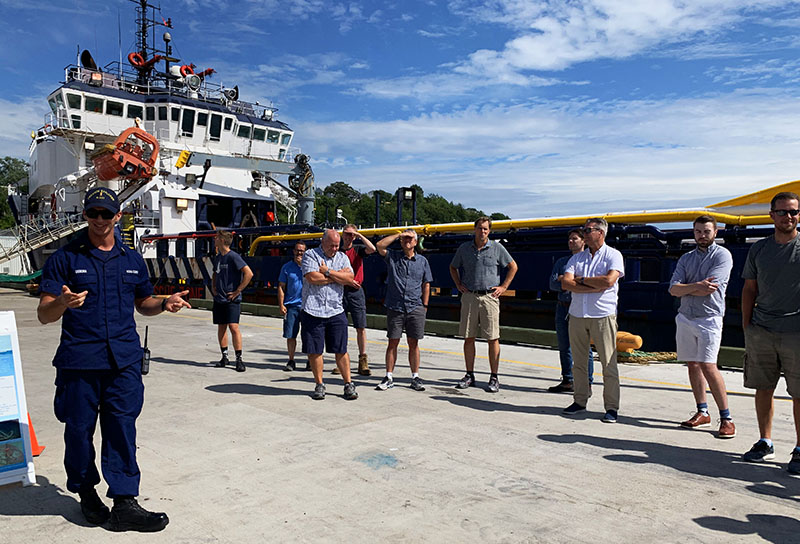
NOAA Corps Ensign Nicolas Osborn welcomes guests to NOAA Ship Okeanos Explorer at the beginning of the ship tours held in Dartmouth, Nova Scotia. Image courtesy of the NOAA Office of Ocean Exploration and Research, Deep Connections 2019. Download image (jpg, 3.6 MB).
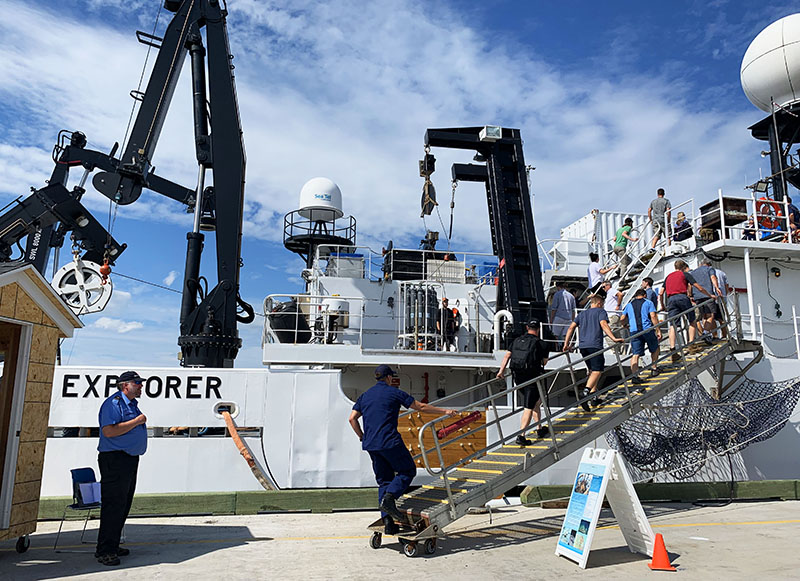
Visitors board NOAA Ship Okeanos Explorer during the ship tours held in Dartmouth, Nova Scotia on August 23, 2019. Image courtesy of the NOAA Office of Ocean Exploration and Research, Deep Connections 2019. Download image (jpg, 4 MB).
Unlike humans, deep-sea biological communities and geological features do not recognize geopolitical boundaries, and therefore, a holistic understanding of our oceans requires collaboration with our neighbors. While every Okeanos Explorer expedition involves input from a myriad of stakeholders, during the planning for the Deep Connections 2019 expedition, we were pleased to work very closely with many partner institutions from Canada. We were fortunate enough to meet several of these partners in person, during the in-port between the first and second legs of the Deep Connections 2019 expedition.
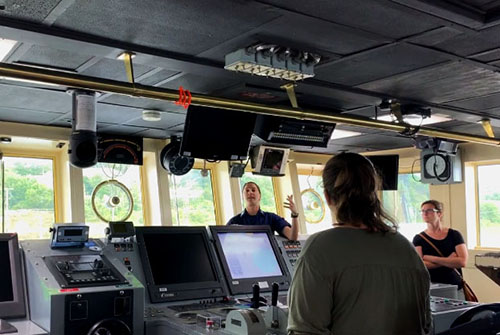
Operations Officer Lieutenant Rosemary Abbitt gives a tour of the bridge of NOAA Ship Okeanos Explorer during the August 23, 2019 ship tours in Dartmouth, Nova Scotia. Image courtesy of the NOAA Office of Ocean Exploration and Research, Deep Connections 2019. Download image (jpg, 172 KB).

Expedition Coordinator Daniel Wagner explains how science operations are run from the mission control room during the August 23, 2019 ship tours in Dartmouth, Nova Scotia. Image courtesy of the NOAA Office of Ocean Exploration and Research, Deep Connections 2019. Download image (jpg, 3.6 MB).
On the afternoon of August 23rd, 2019, we hosted a series of four tours of NOAA Ship Okeanos Explorer while the ship was docked at the Center for Ocean Ventures and Entrepreneurship (COVE) pier in Dartmouth, Nova Scotia. These one-hour tours provided an inside look at how NOAA Ship Okeanos Explorer operates, with opportunities to see the bridge, mission control room, remotely operated vehicles (ROVs), and lab spaces, as well as to speak directly with members of the Okeanos Explorer team. Over 80 local partners attended the ship tours, including representatives from Canadian management agencies, academic institutions, non-governmental institutions, and the private sector, with many attendees coming specifically from Fisheries and Oceans Canada, the Canadian Geological Survey, Dalhousie University, and COVE.
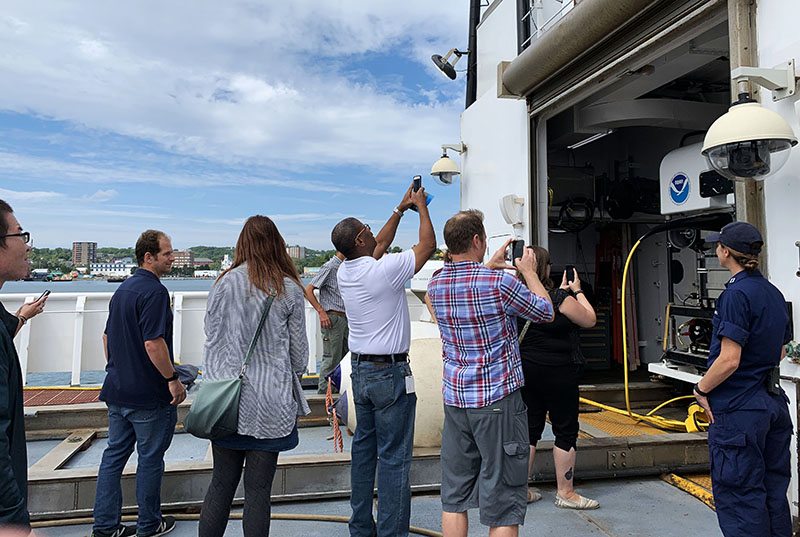
Visitors take photos of ROV Deep Discoverer during the August 23, 2019 ship tours in Dartmouth, Nova Scotia. Image courtesy of the NOAA Office of Ocean Exploration and Research, Deep Connections 2019. Download image (jpg, 3.4 MB).
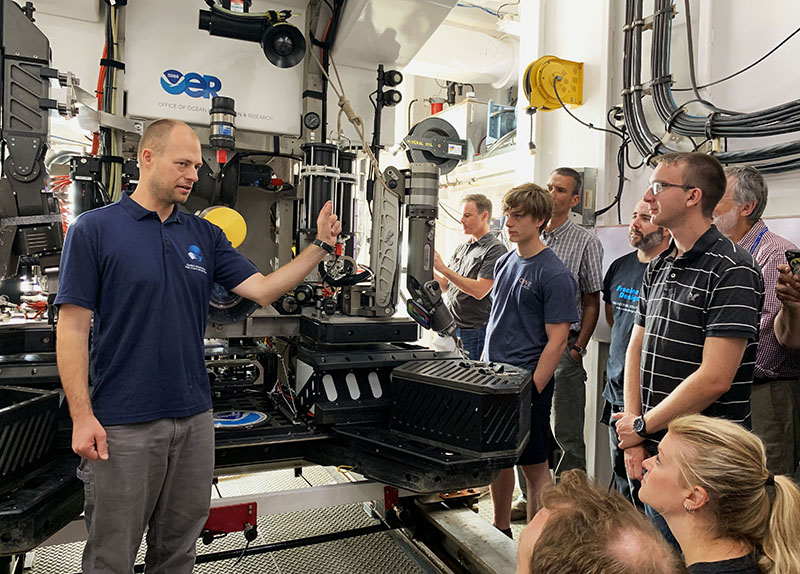
Engineer Dan Rogers, from the Global Foundation for Ocean Exploration, gives visitors a close-up look at ROV Deep Discoverer. Visitors were able to learn about the technological features of this submersible vehicle during the ship tours held on August 23, 2019 in Dartmouth, Nova Scotia. Image courtesy of the NOAA Office of Ocean Exploration and Research, Deep Connections 2019. Download image (jpg, 3.9 MB).